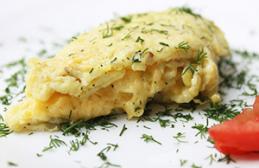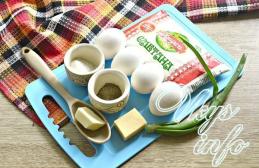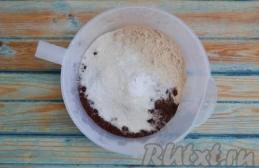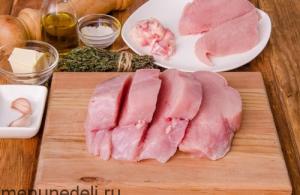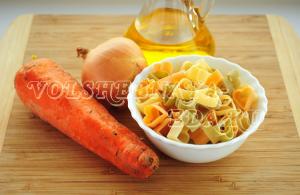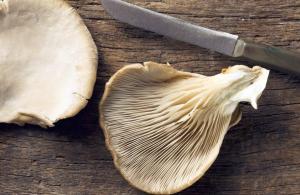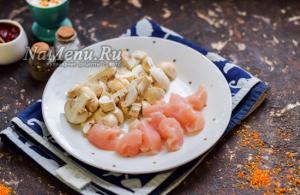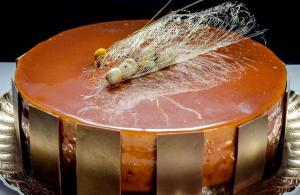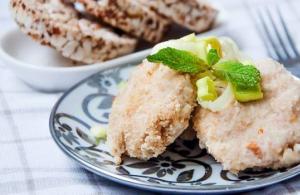On February 16, at the Agropishcheprom Scientific and Production Center, as a continuation of the food quality control program, a tasting of canned fish “Natural saury” and “Saury with added oil” was held.
Canned fish have been adding variety to our diet for a long time, and sometimes they replace fresh fish for us, but let’s try to figure it out how successful it is.
Based on the results of laboratory tests, all samples met the requirements of industrial sterility, and in terms of the content of toxic elements also complied with the unified sanitary-epidemiological and hygienic requirements for products (goods) subject to sanitary-epidemiological supervision (control) and the Sanitary-epidemiological rules and regulations "Hygienic Requirements to the safety and nutritional value of food products. SanPiN 2.3.2.1078-01”, therefore, all samples are safe for the consumer. Canned food was purchased from popular retail chains: Auchan LLC, Lyubimye Produkty LLC, O’KEY LLC, Tander CJSC (Magnit store chain), Iceberg shopping center.

A tasting commission was formed, with Candidate of Agricultural Sciences Artem Yurievich Chukhlantsev acting as the main expert. Together with his assistants - canning industry technologists - Marina Yuryevna Pavlova and Tatyana Aleksandrovna Govorova, Artem Yuryevich compiled a tasting program during which the criteria for assessing the organoleptic characteristics of products were discussed, after which the experts were able to begin assessing the visual attractiveness of the samples and the tasting itself.
Employees of the Research and Production Center were asked to evaluate the quality of canned food, among them Mikhail Ivanovich Boldyrev, professor, Doctor of Agricultural Sciences, Honored Scientist of the Russian Federation, Chairman of the Scientific and Technical Council of the Agropishcheprom Research and Production Center.
A wide range of tasting samples, which has become a tradition at the Agropishcheprom Scientific and Production Center, included 22 items, of which 11 samples were “Natural saury” and 11 samples “Saury with added oil”.
Despite the fact that all samples meet the indicators for the content of toxic elements, comply with uniform sanitary-epidemiological and hygienic requirements for products, already on the first sample of saury, experts were faced with an unpleasant reality - the presence of acanthocephals - acanthocephalans - in canned food Echinorhynchus gadi and Radinorhynchus trachuri, which most often affects saury. Acanthocephalans are localized in the intestines of fish, sometimes in significant quantities. They are quite large in size, up to 13-35 mm in length and 0.7-0.9 mm in width, and have a long proboscis armed with hooks, with which they attach to the intestinal walls. Since the intestines are removed when cutting fish, these helminths no longer pose any danger to humans. When preparing saury for canning and cutting it into pieces for putting in jars, sometimes violations are made by poorly washing the fish or leaving part of the intestines, and in such cases acanthocephalans end up in the canned food. When opening the jar, red acanthocephalic helminths are found in the oil right on the surface of its contents. When purchasing such canned goods, customers usually return them to the store. It is necessary to discard significant batches of canned food if, when opening the cans, more than 8 specimens of acanthocephala are found in the surface layer of oil. To prevent acanthocephalans from getting into canned food, veterinary and sanitary control over the cutting of saury must be carefully carried out. When preparing it for canning, it is necessary to completely remove the intestines of the fish and thoroughly wash the carcass, which guarantees the preparation of canned food of good quality, without the presence of helminths - acanthocephalans. It is worth noting that the first sample was not the only one.



Due to the fact that in the following samples of canned food: “Natural saury” of the brands “Dalmoreprodukt”, “Primrybsnab”, “Saury with added oil” of the brands “Trading House Sea Commonwealth”, “Dobroflot” (smoked in oil), “ Primrybsnab" acanthocephalans were discovered, experts rejected them as not corresponding to organoleptic indicators, as a result of which they were not evaluated.
The remaining samples were assessed on a 5-point scale.
Unfortunately, not all canned foods fully satisfied the requirements of organoleptic evaluation.
"Natural saury"

"Natural saury"
The leaders in the tasting of natural saury were three samples of canned food:
Pacific saury natural Trade mark "MAYAK" - 4.18 points. Manufacturer: LLC APK "Slavyansky-2000", shelf life 24 months. Net weight 250 g. Natural saury Trademark “Every Day” - 4.06 points. Manufacturer: Balt-Fish Plus LLC. Shelf life: 3 years. Net weight 240 g. Saury in its own juice Trade mark “FORTUNA” - 4.05 points. Manufacturer: Golden Prize Kenning Co Ltd. Thailand. Distributor in the Russian Federation: Mistral Trading LLC. Shelf life: 4 years. Net weight 185 g. Net weight of the main product 130 g.



But, all canned food - the tasting leaders - have minor deviations from labeling standards.
The sample that scored the lowest number of points was Pacific saury natural Trademark “Sea Inside” - 3.74 points. Manufacturer: JSC Yuzhmorrybflot, plant No. 13, Nakhodka. By order of Aquator LLC. Shelf life 36 months. Net weight 240 g.

"Saury with added butter"

"Saury with added butter"
Natural Pacific saury with added oil Trade mark “DOBROFLOT” became the most distinguished product for its high level of quality, it scored 4.21 points. Manufacturer: ZAO Yuzhmorrybflot. Made at sea from freshly caught fish. Shelf life: 3 years. Net weight 245 g. This type of canned food has become a leader with a decent lead over its competitors. The following steels in terms of quality are: Pacific natural saury with added oil Trade mark “Tasty canned food” - 3.8 points. Manufacturer IP Dunin G.E. Fish canning plant No. E-90. Shelf life: 24 months. Net weight 185 g. Saury with added butter Trade mark “Sea Inside” - 3.74 points. Manufacturer: PRDP Preobrazhensky Fish Factory CJSC, Primorsky Krai. By order of Aquator LLC. Shelf life 36 months. Net weight 250 g.



The sample that lags behind the others according to the results of the examination was natural Pacific saury with the addition of oil Trademark “UNIMARKA” - 3.28 points. The products are made from frozen raw materials. Manufactured by Golden Prize Canning Co. LTD. Importer to the Russian Federation is Brigantina LLC. Shelf life: 3 years. Net weight 230 g.

All other canned goods were rated within 3.3 - 3.7 points, and correspond to organoleptic indicators with minor deviations. The labeling on some cans has shortcomings, the most common of which are: an unreadable label, lack of a mark on the expiration date and storage conditions after opening the consumer package.
Summing up the results of the tasting, the expert commission formulated several basic recommendations for choosing canned saury natural and saury in oil. Standing in front of the counter in a store, you shouldn’t pay attention to the most beautiful, bright and expensive cans of canned food. After all, neither an attractive design nor a high price guarantees the consumer that there will be no “pleasant” surprises in the jar, for example, acanthocephali - acanthocephalans, which, despite their safety for food consumption, not only spoil the appetite with their appearance, but also in the body of which heavy metals accumulate. Experts from SPC "Agropischeprom" do not recommend consuming such products as food; it is better to dispose of the jar. In addition, it is worth paying attention to where the products are made; the closer the production is to the places where saury is caught or the production is located directly at sea, the higher the likelihood that the quality and freshness of the raw materials will be.
And of course, after opening the jar, pay attention to the color, smell and consistency of the canned food. If you feel an unpleasant odor or the color of the filling is too dark with a lot of sediment or an unnatural shade, if red-orange worms - acanthocephalans - are visible on the surface, if when putting the fish out of the jar it breaks down a lot and has a bitter, unpleasant taste - it is better not to eat such products. SPC "Agropischeprom" continues its food quality control program and has prepared for you a lot of interesting and useful information about what is on the shelves of our stores!
















Back in the distant 70s, canned saury became more popular than sprat, and at the same time was sold at a very affordable price. Decades later, natural Pacific saury also often ends up on the dinner table, and you can still buy it for a reasonable price.
Benefits for humans
The beneficial properties of this fish lie in its rich vitamin and mineral composition (contains Omega-3 fatty acids and antioxidants, as well as iron, potassium, calcium, magnesium, phosphorus, fluorine) and are confirmed by many studies in Russia and abroad. Canned Pacific natural saury is recommended by nutritionists to be consumed regularly for a balanced diet.
Description and Application
It is worth noting the “correct” calorie content of canned food, they perfectly saturate the body and satisfy the feeling of hunger, and do not contain carbohydrates, that is, they are safe for the figure. Canned saury is often added to homemade soups and salads, baked into aromatic pies, served as a snack, and also used to make fish cutlets. Thanks to proteins of natural origin, canned natural saury is perfectly digestible and does not cause excess weight.
We offer seafood
We produce canned fish on the high seas in order to preserve all the beneficial properties of Pacific fish, eliminating the need to freeze raw materials for subsequent transportation.
We supply canned Pacific natural saury wholesale and retail throughout the Russian Federation, where you can buy products under the Dobroflot brand at the price from the manufacturer.
GOST 13865-2000
Group H23
INTERSTATE STANDARD
NATURAL CANNED FISH WITH ADDED OIL
Specifications
Canned fish in natural juice with oil. Specifications
MKS 67.120.30
OKP 92 7139
Date of introduction 2004-01-01
Preface
Preface
1 DEVELOPED by the Pacific Research Institute of Fisheries and Oceanography (TINRO), State Order of the Badge of Honor Research and Design Institute for the Development and Operation of the Fleet (Giprorybflot)
INTRODUCED by Gosstandart of Russia
2 ADOPTED by the Interstate Council for Standardization, Metrology and Certification (Protocol No. 18 of October 18, 2000)
The following voted for adoption:
State name | Name of the national standardization body |
The Republic of Azerbaijan | Azgosstandart |
Armenia | Ministry of Economy of the Republic of Armenia |
Republic of Belarus | State Standard of the Republic of Belarus |
Russian Federation | Gosstandart of Russia |
Georgia | Gruzstandart |
The Republic of Kazakhstan | Gosstandart of the Republic of Kazakhstan |
Republic of Kyrgyzstan | Kyrgyzstandard |
The Republic of Moldova | Moldova-Standard |
The Republic of Tajikistan | Tajikstandard |
Ukraine | Gospotrebstandart of Ukraine |
(Amendment. IUS No. 6-2019).
3 By Decree of the State Committee of the Russian Federation for Standardization and Metrology dated June 30, 2003 N 231-st, the interstate standard GOST 13865-2000 was put into effect directly as a state standard of the Russian Federation from January 1, 2004.
4 INSTEAD GOST 13865-68
5 REPUBLICATION. January 2009
An amendment has been made, published in IUS No. 6, 2019, taking into account the clarification published in IUS 11-2019
Amendment made by database manufacturer
1 area of use
This standard applies to natural canned fish with the addition of oil and establishes requirements for products manufactured for the domestic market and for export.
Requirements for product quality and safety are set out in 4.1, 4.2.1, 4.2.2, 4.2.4, 4.2.5 (indicators “Taste”, “Smell”, “Presence of foreign impurities”), 4.3.2, 4.4, 4.5. 1, 4.5.3, 7.3.
2 Normative references
This standard uses references to the following standards:
GOST 814-96 Chilled fish. Specifications
GOST 1128-75 Refined cottonseed oil. Specifications
GOST 1129-93 Sunflower oil. Specifications*
________________
GOST R 52465-2005.
GOST 1168-86 Frozen fish. Specifications
GOST 1723-86 Fresh onions, prepared and supplied. Specifications
GOST 3343-89 Concentrated tomato products. General technical conditions
GOST 5981-88 (ISO 1361-83, ISO 3004-1-86) Metal cans for canned food. Specifications
GOST 7587-71 Dried onions. Specifications**
________________
GOST R 52622-2006.
GOST 7825-96 Soybean oil. Specifications
GOST 8756.0-70 Canned food products. Sampling and preparing them for testing
GOST 8756.18-70 Canned food products. Method for determining the appearance, tightness of containers and the condition of the internal surface of metal containers
GOST 8807-94 Mustard oil. Specifications
GOST 8808-2000 Corn oil. Specifications
GOST 10444.1-84 Canned food. Preparation of solutions of reagents, paints, indicators and nutrient media used in microbiological analysis
GOST 10444.2-94 Food products. Methods for identifying and quantifying Staphylococcus aureus***
________________
*** GOST R 52815-2007 is in force on the territory of the Russian Federation.
GOST 10444.7-86 Food products. Methods for detecting botulinum toxins and Clostridium botulinum
GOST 10444.8-88 Food products. Method for identifying Bocillus cereus
GOST 10444.9-88 Food products. Method for determining Clostridium perfringens
GOST 10444.11-89 Food products. Methods for determining lactic acid microorganisms
GOST 10444.12-88 Food products. Method for determining yeast and mold fungi
GOST 10444.15-94 Food products. Methods for determining the number of mesophilic aerobic and facultative anaerobic microorganisms
GOST 11771-93 Canned food and preserves from fish and seafood. Packaging and labeling
GOST 13830-97 Table salt. General technical conditions*
________________
* GOST R 51574-2000 is in force on the territory of the Russian Federation.
GOST 14192-96 Marking of cargo
GOST 17594-81 Dry bay leaf. Specifications
GOST 20057-96 Frozen oceanic fish. Specifications
GOST 23285-78 Transport bags for food products and glass containers. Specifications
GOST 24597-81 Packages of packaged piece goods. Main parameters and dimensions
GOST 26663-85 Transport packages. Formation using packaging tools. General technical requirements
GOST 26664-85 Canned food and preserves from fish and seafood. Methods for determining organoleptic indicators, net weight and mass fraction of components
GOST 26668-85 Food and flavoring products. Sampling methods for microbiological analyzes
GOST 26669-85 Food and flavoring products. Preparation of samples for microbiological analyzes
GOST 26670-91 Food products. Methods for cultivating microorganisms
GOST 26927-86 Raw materials and food products. Mercury determination method
GOST 26929-94 Raw materials and food products. Sample preparation Mineralization to determine the content of toxic elements
GOST 26930-86 Raw materials and food products. Arsenic determination method
GOST 26931-86 Raw materials and food products. Methods for determining copper
GOST 26932-86 Raw materials and food products. Lead determination methods
GOST 26933-86 Raw materials and food products. Methods for determining cadmium
GOST 26934-86 Raw materials and food products. Zinc determination method
GOST 26935-86 Canned food products. Tin determination method
GOST 27166-86 Fresh onions for sale. Specifications**
________________
** GOST R 51783-2001 is in force on the territory of the Russian Federation.
GOST 27207-87 Canned food and preserves from fish and seafood. Method for determining table salt
GOST 29045-91 Spices. Allspice. Specifications
GOST 29050-91 Spices. Black and white pepper. Specifications
GOST 29053-91 Spices. Ground red pepper. Specifications
GOST 30425-97 Canned food. Method for determining industrial sterility
3 Classification
The range of canned food produced according to this standard:
- natural carp with added oil;
- natural flounder with added oil;
- cut natural Caspian sprat with added oil;
- natural ice fish with added oil;
- natural pollock with added oil;
- natural navaga with added oil;
- natural burbot with added oil;
- natural burbot with the addition of flavored oil;
- natural blue whiting with added oil;
- natural pilengas with added oil;
- natural saber fish with added oil;
- natural Pacific saury with added oil;
- natural bream with added oil;
- natural catfish with added oil;
- Atlantic sardine “Appetizing”;
- natural Atlantic sardine with added oil;
- natural sardinella with added oil;
- natural Atlantic sardine with the addition of flavored oil;
- natural sardinella with the addition of flavored oil;
- natural Atlantic herring with added oil;
- Atlantic mackerel “Appetizing”;
- Atlantic mackerel "New";
- natural Atlantic mackerel with added oil;
- natural Far Eastern mackerel with added oil;
- ocean mackerel "Appetizing";
- natural oceanic horse mackerel “Aromatic”;
- ocean mackerel "Novinka";
- natural ocean mackerel with added oil;
- natural silver carp with added oil;
- natural pike with added oil;
- natural cod with added oil;
- natural hake with the addition of flavored oil "Novinka"
3.2 According to the standard, another assortment of canned food can be produced, if there is an assortment mark.
4 Technical requirements
4.1 Canned food must be manufactured in accordance with the requirements of this standard according to technological instructions in compliance with sanitary standards and rules approved in the prescribed manner.
4.2 Characteristics
4.2.1 Fish must be cut, placed in jars with the addition of flavored or unflavored vegetable oil, hermetically sealed and sterilized at temperatures above 100°C.
4.2.2 Canned food must meet the requirements of industrial sterility.
4.2.3 In terms of chemical indicators, canned food must comply with the standards specified in Table 1.
Table 1
Indicator name | Test method |
|
Mass fraction of table salt, % |
4.2.4 In terms of safety indicators, canned food must comply with the hygienic requirements established by the state sanitary and epidemiological supervision authorities.
4.2.5 In terms of organoleptic indicators, canned food must meet the requirements specified in Table 2.
table 2
Indicator name | Characteristics and norm |
Pleasant, characteristic of canned food of this type, without any extraneous taste or bitterness |
|
For canned food with the addition of flavored oil with a slight taste of the constituent components |
|
Pleasant, characteristic of canned food of this type, without any foreign smell. |
|
For canned food made with onions, dill, spices or flavored oils - with a slight aroma of the constituent components |
|
Consistency: | |
Fish meat | Juicy. Horse mackerel may have dense |
Bones | Soft |
State: | |
Whole pieces and carcasses. The cross section of pieces or portions of fish is smooth. |
|
Can be: |
|
Partial baking of meat and skin to the inner surface of the jar; |
|
Slight protrusion of the vertebral bone above the level of the meat; |
|
Small pieces of skin or meat near the lid and bottom in separate jars; |
|
Coagulated protein flakes; |
|
Breaking individual pieces and carcasses of fish when putting them out of a jar; |
|
Oblique cuts in individual pieces of fish. |
|
Broth | Liquid with added oil, suspended protein particles, skin and fish crumbs |
Fish meat | Characteristic of boiled meat of this type of fish. |
Broth | Light. May be: |
Change in broth color when flavored oil is added; |
|
Slight cloudiness from suspended protein particles |
|
Cutting characteristics | The head, entrails, “bugs” (bone formations), fins, black film were removed, blood clots were cleaned out. |
Canned food may contain: |
|
Fins (except the tail) for small fish with a carcass length of no more than 14 cm and for saury, sardine, sardinella, herring, mackerel, horse mackerel; |
|
A transverse incision of the abdomen near the anus when cutting fish without cutting the abdomen; |
|
Cutting characteristics | Cutting off the lower part of the abdomen; |
Remains of entrails, caviar or milt, black film in carcasses and in individual pieces of saury, sardine, sardinella, herring, mackerel, horse mackerel and hake |
|
Presence of scales | Deleted. |
It is possible to leave scales on horse mackerel, mackerel, cod and hake; individual scales of sardinella, sardine |
|
Laying order | Pieces of fish should be tightly laid with a cross cut to the bottom and lid of the jar. |
The height of pieces or portions of fish should be equal to the internal height of the jar or be 4-5 mm lower than it. |
|
Individual pieces of fish can be laid flat or in two rows. |
|
Fish carcasses should be laid in parallel rows with the belly up or flat, or in a ring shape: the first row - with their backs down, the subsequent ones - with their backs up, head to tail |
|
Presence of foreign impurities | Not allowed |
4.3 Requirements for raw materials and materials
4.3.1 Raw materials and materials used for the production of canned food must be at least first grade (if grades are available) and correspond to:
- raw fish - to the regulatory document;
- chilled fish - GOST 814;
- frozen fish - GOST 1168, GOST 20057, GOST 21230 and regulatory documents;
- table salt - GOST 13830;
- refined sunflower oil - GOST 1129;
- refined soybean oil - GOST 7825;
- refined corn oil - GOST 8808;
- mustard oil -

